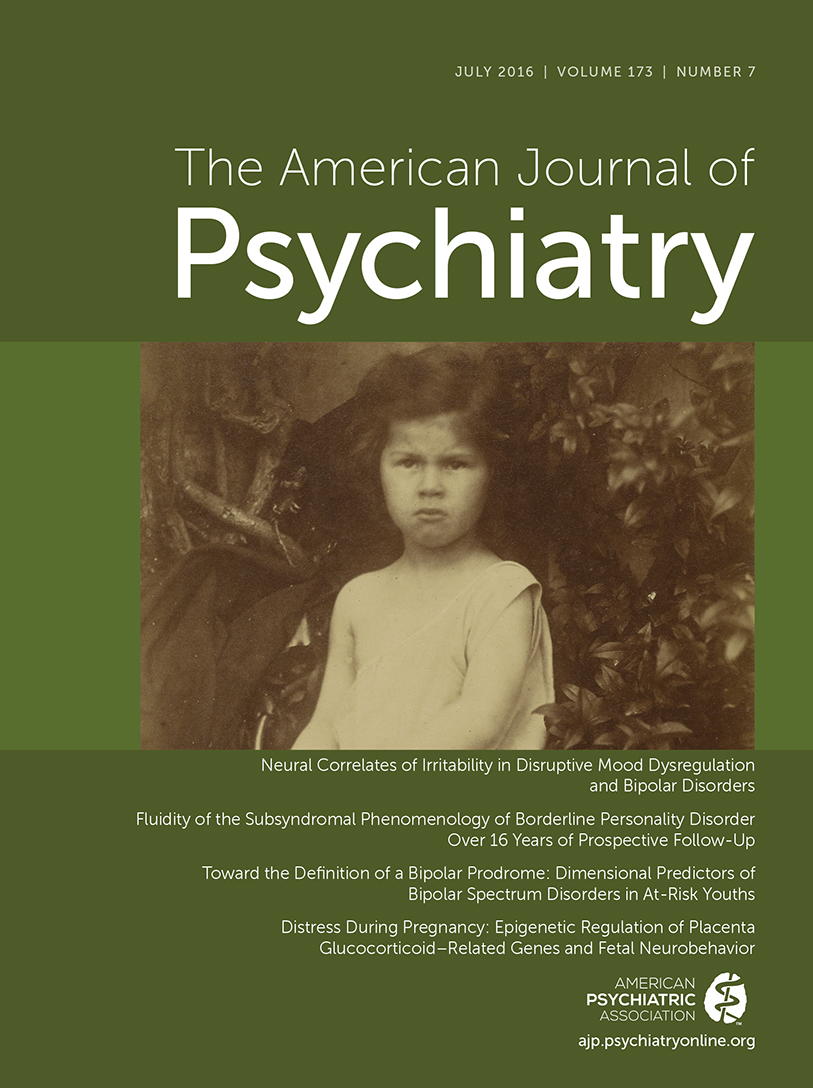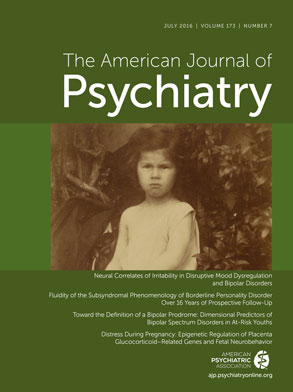Stress and stressors to the pregnant mother have long been implicated in adverse pregnancy outcomes such as preterm birth (
1–
3) and low birth weight infants (
4,
5), postpartum depression (
6), and are a risk factor for later psychiatric illness in the developing child (
7,
8). How stress leads to these outcomes has been difficult to elucidate, and long-term follow-up of mothers and their children, with incorporation of prenatal and postnatal biomarkers, poses many research and pragmatic challenges. Stressed mothers, who frequently meet criteria for anxiety and depression, partially transmit the risk for these illnesses to their babies through their genetics. These mothers may also have difficulties in parenting after birth that can further contribute adversely to the child’s development (
9,
10).
In this issue of the
Journal, Catherine Monk, Ph.D., and her collaborators (
11) describe a third mechanism, the epigenetic modification of glucocorticoid genes in the placenta as part of the mother’s perception of, and response to, stress. This investigation was driven by the hypothesis that higher maternal distress would alter DNA methylation of genes associated with glucocorticoid transfer across the placenta, thereby altering fetal exposure to maternal glucocorticoids. Furthermore, the authors hypothesized that elevated maternal cortisol would be associated with less DNA methylation of the gene that regulates the enzyme involved in blocking cortisol transfer across the placenta. Both psychological and physiologic measures of prenatal distress were hypothesized to influence fetal neurobehavior in association with placental methylation differences.
In 61 pregnant women, the authors examined four psychological measures of stress and mood (perceived stress, depression, anxiety, and pregnancy-specific stress) and a maternal physiologic stress marker of hypothalamic-pituitary-adrenal (HPA) axis function (salivary cortisol area under the curve) measured between 24 and 27 weeks gestation. They included a fetal assessment of autonomic nervous system function and maturation, termed “coupling,” measured between 34 and 37 weeks gestation. The measure “coupling” is a ratio of fetal movement and fetal heart rate, with higher levels of coupling being associated with improved neural integration at birth (
12,
13). Both psychological and physiologic maternal measures were analyzed in relation to methylation patterns of three glucocorticoid-related placental genes and in relation to fetal movement and fetal heart rate “coupling” in the late third trimester.
Overall, the study population had low maternal distress scores, favorable pregnancy outcomes such as delivery at term of babies with a normal range of birth weights, and overall small absolute degrees of placental methylation variation for the three genes assessed. No association was noted between psychological and physiologic measures of maternal distress or between these measures and fetal coupling. Additionally, there was no association between maternal cortisol area under the curve and methylation of any of the glucocorticoid genes assessed. What the authors did discover were relationships between maternal mood, placental DNA methylation of the gene that codes for the enzyme 11-beta-hydroxysteroid dehydrogenase type 2, a “barrier enzyme that inactivates cortisol,” and fetal coupling (
14). Greater methylation of this gene was significantly associated with less fetal coupling. More methylation of this gene presumably leads to less enzyme expression and less inactivation of cortisol by the placenta. Thus, this alteration would lead to more fetal cortisol exposure, and more fetal cortisol exposure is associated with changes in brain-behavior development, including increased emotionality and impaired learning and motor development (
15). While early childhood developmental changes resulting from altered placental methylation were not assessed in this study, a difference in fetal coupling was ascertained. From the data presented, therefore, we may infer that the finding of less fetal coupling in this study may be driven by increased fetal cortisol exposure secondary to increased methylation.
The authors further divided the participants into methylation tertiles and discovered that placentas in the lowest tertile of methylation of HSD11B2 were associated with lower mean Perceived Stress Scale scores than those in the highest tertile. Clinically, this suggests that mothers who are least distressed produce placentas that have less methylation of the cortisol deactivating gene and are more successful at buffering their fetuses from the negative influence of stress. Placentas in the lowest tertile of methylation of HSD11B2 were also associated with higher (better) fetal coupling than those in the highest tertile. Combined, these findings suggest that the placenta is capable of “responding to” maternal perceived stress in a mechanism that may be protective against excessive maternal-to-fetal cortisol exposure when mothers have lower perceived stress. Using mediation analysis, the authors determined that perceived stress was associated with more methylation, which was also associated with lower fetal coupling. The indirect effect of perceived stress on fetal coupling through methylation was significant. Thus, methylation patterns appear to significantly mediate the relationship of perceived stress with coupling.
The modification, varying methylation of two out of three studied genes in some, but not all, placental cells, is small. However, this modification is correlated with both maternal perception of stress in the late second trimester of pregnancy and a marker of fetal neurodevelopment in the late third trimester. Fetuses have improved autonomic nervous system tone as they mature (
16) and would be expected to have improved “coupling” as they progress in gestation. The authors assessed fetuses between 34 and 37 weeks and did not adjust for increasing gestation as part of the coupling assessment. Further adjustment for gestational age should be a consideration in future studies as should the use of this measure versus a visual measure of fetal movement, as maternal report of fetal movement may not capture all movements that occurred during the study assessment (
17). Additionally, the fetal coupling measure serves as a surrogate marker for altered autonomic nervous system function and neurodevelopment and has not been correlated with long-term child neurodevelopment and the development of psychiatric illness. Nonetheless, it provides us with a near “real-time” intrauterine relationship that captures components of several systems: the maternal HPA axis, the role of placenta in regulating maternal-fetal stress, and fetal autonomic system neurodevelopment in the presence of factors influenced by both psychological and physiologic stress.
Epigenetic changes in corticosteroid relationships have been reported in an intervention study assessing the effect of choline supplementation on maternal-fetal cortisol status and placental methylation of glucocorticoid genes (
18). Stress-related epigenetic changes in metabolism have been reported in other studies of adults, such as Holocaust survivors (
19). However, this study raises the additional possibility that stress perceived by the mother, a psychological measure, is transmitted across a generation to affect the function of the placenta and, thus, the fetus at its most vulnerable time in brain and autonomic system development. Therefore, stress during pregnancy, interacting with both the mother’s and the baby’s genes, can have life-long effects on the baby’s development through childhood and into adulthood.
There are psychiatric ramifications of the Monk et al. study. A gene-by-environment model has been part of every biopsychosocial model of both healthy and dysfunctional development. These findings emphasize the importance of early, appropriate, aggressive therapies for maternal distress and psychiatric illness to potentially mitigate the methylation patterns of stress-regulating genes in the placenta that vary as a function of adversity during pregnancy.
Looking to the future, this study by Monk et al. encourages biologists to dig deeper to discover just how distress changes the methylation pattern of placental genes. Decades of research on the developmental origins of health and disease indicate that the evolution of health over the life-course is a process that begins in utero. These data add molecular support to the developmental origins of disease hypothesis and emphasize the importance of maternal mental state on maternal health, pregnancy outcomes, and the health and behavior of her child. If we cannot protect all mothers from stress, perhaps we can investigate better ways of protecting their placentas and, thereby, their children from its multigenerational effects.

